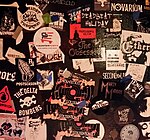25th Street Station was a proposed mixed use development to be located in the Remington, Old Goucher, and Charles Village neighborhoods of central Baltimore. It received final design approval from Baltimore's Planning Commission on December 16, 2010, and was to commence construction in early 2011, with a 2012 opening. The development would have included 330,000 square feet (31,000 m2) of retail space, including a Walmart and Lowe's as anchor tenants, with an array of smaller retailers and 70 apartments. As of October 2011 construction of 25th Street Station has not begun yet and the Lowe's is no longer an anchor.On May 20, 2014, the project's primary developer, WV Urban Developments, withdrew from the project, citing numerous ongoing legal issues and challenges as the cause. The WV Urban's project manager for the site upon the announcement of its withdrawal stated, "WV Urban Developments is no longer pursuing its 25th Street Station project. As you are well aware, the project has been the target of numerous appeals and filings by opponents, which have delayed the project for years." The appeals were stated to "have contributed to an environment sufficiently uncertain that the relevant parties are unable to reach the agreements necessary for WV to continue." WV Urban Developments had spent more than $5 million in planning costs and attorney's fees defending the project against lawsuits that had been dismissed but appealed.
As of August 2015, the 25th Street Station project is essentially dead, as WV Urban Developments sold the land that was to be used for the 25th Street Station project to a new developer, Seawall Development Co. (who has a proven track record of locally-oriented development and community engagement within Baltimore City) in late-2014 who on March 17, 2015 agreed with the communities that surrounded this project that they would not develop the property in accordance to the 25th Street Station PUD and the November 21, 2013 decision by the Baltimore City Planning Commission (essentially killing the proposed Walmart that was highly controversial from the original proposal) and would not oppose to a potential action by the Baltimore City Council and the Planning Commission to cancel or repeal the 25th Street Station PUD in exchange for the dismissal of two appeals pending within the Maryland Court of Special Appeals that was filed in opposition of the 25th Street Station project.The proposed site is bounded by West 25th Street to the north, Maryland Avenue to the east, West 24th Street to the south, and the CSX Railroad line to the west.








